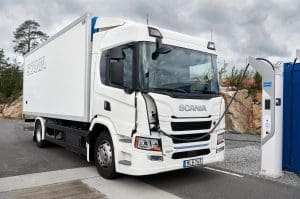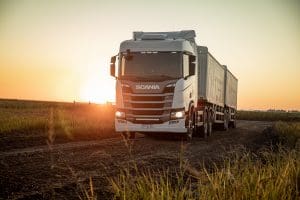Scania Argentina, a branch of Swedish commercial vehicle and engine manufacturer, Scania, has implemented two major goals to reduce emissions. By 2025, it expects to cut carbon dioxide (CO2) emissions from its operations by 50% and from its products by 20% (compared to 2015 levels). By 2050, it plans to completely decarbonize its entire trucking fleet. Scania views decarbonization as feasible and beneficial for society as a whole. Its new Green Efficiency line and electric truck line are the first steps in a 30-year journey toward reducing, and eventually eliminating, CO2 emissions.
For decades, diesel has been a staple in the commercial transportation industry. Up until now, Scania’s emission reduction efforts have more or less centered around burning diesel more efficiently. It has implemented other alternative fuels to work with diesel, such as liquefied or compressed biogas, ethanol, hydrogenated vegetable oil, and fatty acid methyl ester (FAME). Switching the primary fuel source from diesel to something else is a new concept entirely.
The company’s Green Efficiency line for urban, suburban, and long-distance transport includes three solutions — compressed natural gas (CNG), liquefied natural gas (LNG), and biogas — that can be used to power trucks and buses, as well as engines for power generation.
The Green Efficiency Line: Trucks
The modular system of the trucks in Scania’s Green Efficiency line allows them to adapt to different business applications. They are specifically designed for urban distribution, waste collection, construction, general cargo, container hook-lift operations, and regional distribution.
The natural gas and biogas engines allow fuel savings and noise reduction of 50% compared to Scania’s diesel versions. There are three engines available: two 9-L (2.4-gal.) engines rated at 260 hp (194 kW) and 340 hp (254 kW), and a 13-L (3.4-gal.) engine rated at 410 hp (306 kW).
Natural gas and biogas can be used in parallel as a fuel source. According to Scania, its product platform enables both types of fuel to be stored in a compressed or liquid form. Scania’s truck engines are designed to run on gas under the Otto cycle (spark ignition) and meet the requirements of the Euro 6 standard.

The cabs were designed and developed to offer less wind resistance, thereby reducing fuel consumption. In terms of technology, the trucks are equipped with cruise control, utilizing Scania’s Active Prediction artificial intelligence (AI). In the case of facing an uphill slope, with the topographic data loaded, the vehicle has the intelligence to know what’s ahead, modifying the driving conditions as needed. The trucks feature a smart and dedicated design to run smoother than a diesel engine, while maintaining the same levels of efficiency and torque, leading to sustainable operation and high performance.

The Green Efficiency Line: Buses
The buses in Scania’s Green Efficiency line have proven experience in major cities, namely, Bogotá and Medellín, Colombia; Madrid; and Stockholm. The operating cost of the natural gas-fueled buses is 40% lower compared to diesel. Axel configurations include 4 x 2, 6 x 2, and 6 x 4, all with a rear steer axle for urban and intercity operations. The diverse line of buses includes safety equipment designed to protect the passengers, driver, and vehicle. Buses are equipped with electronic stability and braking sensors. Wide doors, air conditioning units, large windows, and easy access throughout the cabin is sufficient for short- and long-distance transport. Scania designed its bus line to limit as much cabin noise and vibration as possible. The bus has a range of about 186 miles (300 km) with 7063 scf (200 m3) of CNG and can charge at any CNG station.
The Green Efficiency Line: Power Generation
Scania also offers natural gas- and biogas-powered engines for power generation that can be used in complex and rugged operations, such as oil fields that require high energy but also have a high amount of gas available to them. Due to Scania’s unique modular system, the components are shared with the rest of the engine, which translates into greater availability of parts, minimal waste, and simple maintenance. The gas solution for Scania engines for power generation is available in a 16-L (12-gal.) displacement V8 and allows working in prime running power (PRP) and continuous operating power (COP) ranges under the Otto cycle.
Embracing Electrification
Operating alongside the Green Efficiency line is Scania’s new electric truck line, the first of its kind for the company. The new Scania eTrucks can be configured with a wide selection of bodywork, including tippers, refuse collectors, general cargo, and more. “At Scania, once it makes sense for our customers to invest in electrified trucks, we will be ready. That time is now,” said Henriksson. “In certain segments, market electrification is now a good investment for our customers. More markets and segments will follow in the coming years. Electrification is also a very important part of our ambition to decarbonize transport. However, electrification can only take off if we work together with our customers and our infrastructure partners. Then we can get electric trucks running on renewable energy out on our roads.”
According to Scania, the new V8 powertrain, when combined with the company’s Opticruise gearbox, results in a fuel savings of up to 6%. The new trucks have 1623 ft.lb. (2200 Nm)
of torque and can be charged with a 130-kW DC standard connection. Power offerings include 770 hp (574 kW), 660 hp (492 kW), 590 hp (440 kW), and 530 hp (395 kW). The new electric trucks are available in both L-cab and P-cab models for urban applications. The 308-hp (230-kW) electric motor gives the truck a 155-mile (250-km) range per charge. The five-battery pack option provides 165 kW-h and the nine-battery pack option provides 300 kW-h. Scania touts that the driver’s comfort, smooth gear changing, and quiet operations of the truck are important for growing cities trying to control noise levels.

The updated version of Scania’s plug-in hybrid model has increased its range to 37 miles (60 km) in true electric mode. The truck has three batteries for a total of 90 kW-h, feeding the 154-hp (115-kW) electric motor, which can reach an 80% charge after 35 minutes. A 280-hp (209-kW) or 360-hp (268-kW) internal combustion engine pairs with the truck’s electric capabilities. “At Scania, we have a very strong purpose, a purpose to drive the shift toward a sustainable transport system. We have also put some very tough targets on ourselves. We have signed up for the science-based target of 2025 to do our part to deliver on the goals of the Paris Agreement. To reach these targets, electrification needs to happen. That is why we are also making a very strong commitment to launch an electric product every year in the coming years. It is about being true to our purpose, delivering on the commitment of science-based targets, and working toward a sustainable transport system,” said Henriksson.
A Sustainable Future
In September 2020, Scania received its fourth consecutive German “green truck” award. Scania’s R540, a 540-hp (403-kW), 13-L DC13 166 engine, had the lowest fuel consumption at 25.14 L (6.6 gal.) per 62 miles (100 km) and the highest velocity at an average speed of 49.97 mph (80.42 km/h). For years, Scania has been working toward a sustainable future through its three core principles of energy efficiency, alternative fuels and electrification, and smart and safe transportation.

In April 2020, Scania Argentina reached a 100% fossil-free deal with Central Puerto S.A. for six wind turbines located in Los Olivos Park in Achiras, Córdoba Province, Argentina. The deal provides Scania with 22,400 MW of annual power needed to run its industrial operations at its Colombres, Tucumán Province, Argentina, plant.
By using renewable wind energy for 100% of the plant’s operations, Scania Argentina is preventing the equivalent of 16,094 tons (14,600 tonnes) of CO2 from entering the atmosphere, in addition to other polluting particles such as sulfur dioxide and nitrogen dioxide. Scania’s deal with Central Puerto was the final piece needed to reach its goal for 100% renewable power generation for all 10 of its international plants. It also brings the company closer to reaching its 2025 and 2050 goals.

















